Agaricus abruptibulbus (Agaricaceae) Abruptly Bulbous Agaricus
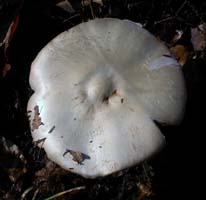 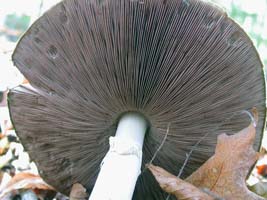 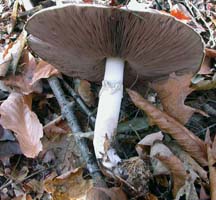 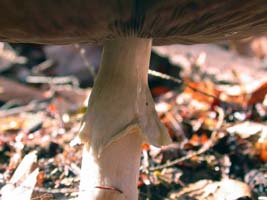
Grows solitary or scattered on soil in mixed woods
Cap – 6 to 15 cm, broadly convex to plane, off-white, dry, dull satin sheen, fine appressed hairs
Gills – free, gray-brown, medium-broad, close to crowded, becoming dark brown as spores develop
Flesh – white, thick, firm, anise-almond odor, yellow color change when bruised gradually turns brown
Stalk – 12cm X 15-25mm, central, cylindrical, curved at base with a squat bulb, dry, off-white, pithy to
narrowly hollow, superior pendulous ring that adheres to stalk with handling
Spores – medium chocolate brown, elliptical, smooth, 7-8 x 4.5-5.5 microns
Comments –considered by some to be a form of A. silvacola without the abrupt bulb. This can be confused with the deadly white Amanita if careless in observing; it has been found in Peninsula State Park in early November.
|
Agaricus bitorquis (Agaricaceae) Spring Agaricus
 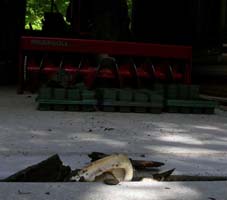 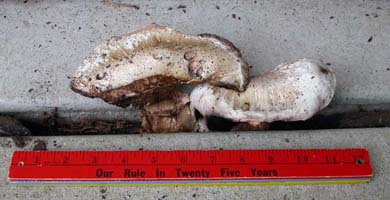
Grows solitary or scattered on soil in mixed woods
Cap – 6 to 15 cm, broadly convex to plane, off-white, dry, dull satin sheen, fine appressed hairs
Gills – free, gray-brown, medium-broad, close to crowded, becoming dark brown as spores develop
Flesh – white, thick, firm, anise-almond odor, yellow color change when bruised gradually turns brown
Stalk – 12cm X 15-25mm, central, cylindrical, curved at base with a squat bulb, dry, off-white, pithy to
narrowly hollow, superior pendulous ring that adheres to stalk with handling
Spores – medium chocolate brown, elliptical, smooth, 7-8 x 4.5-5.5 microns
Comments –considered by some to be a form of A. silvacola without the abrupt bulb. This can be confused with the deadly white Amanita if careless in observing; it has been found in Peninsula State Park in early November.
|
Agaricus cretacellus (Agaricaceae) No common name
 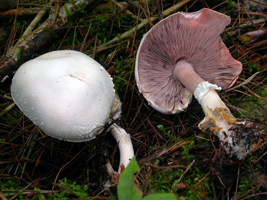
Grows scattered on soil in mixed conifer woods
Cap – 7 to 10cm, convex to plane in age, white to very pale tan, smooth to finely tomentose with a slightly scaly margin, dry.
Gills – free, white to medium pink-brown turning dark brown as spores develop, close to crowded, medium-broad
Flesh – white, thick, mild pleasant odor, no red or yellow stains when cut or bruised.
Stalk – central and curved, 8 to 9cm tall, apex 1cm wide smooth & light brown; base 2cm wide with small bulb, tan, fibrous-striate, cartilaginous, pithy interior, median-superior flaring ring
Spore print – chocolate brown
Spores – elliptical, smooth, 4-6 x 3 microns.
NEW SPECIES TO DOOR COUNTY, found at Toft Point on September 2, 2013.
|
Agaricus haemorrhoidarius (Agaricaceae) Bleeding Agaricus
 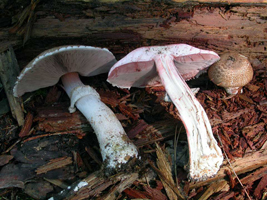
Grows solitary to scattered on soil under conifers
Cap – 6 to 8 cm, broadly convex, brown flat scales on pale tan background, paler incurved margin, dry
Gills – Free, close to crowded, pale tan at first soon dark with spores, broad,
Flesh – Whitish but quickly turns red when cut, medium thick
Stalk – 9 to 10 cm by 8 to 12 mm, flexuous, tan above superior ring, medium brown and smooth below ring, turns red brown where cut, tapers downward
Spore print – Chocolate brown
Spores – 5.5-7.5 x 3.5-4.5 microns, elliptical, entire
Comments: This very uncommon species was reported only twice in Door County, found at Newport State Park on 8-14-86 (a wet summer) and at Toft Point on 8-18-98. |
Agaricus silvicola (Agaricaceae) Woodland Agaricus
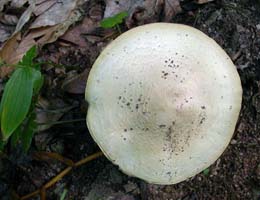 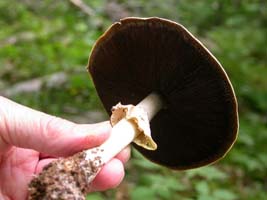
Grows scattered to clustered on soil in mixed woods or on gravel roads and shoulders
Fruiting body – 6–20 mm wide, deep orange, smooth top, shallow disk, no stem, underside has fine hairs near margin and is whitish, very fragile, breaking easily
Spores – white or clear, football shape, tuberculate, some have 2 oil drops, 15-21 x 8-11 microns
Comments – It has been found from mid-summer to late October at Toft Point and a Land Trust property
|
Aleuria aurantia (Pyronemataceae) Orange Peel Fungus
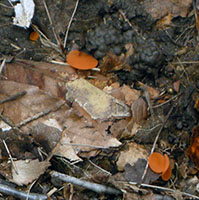 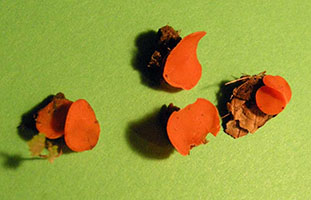
Grows solitary to scattered on soil under conifers
Cap – 6 to 8 cm, broadly convex, brown flat scales on pale tan background, paler incurved margin, dry
Gills – Free, close to crowded, pale tan at first soon dark with spores, broad,
Flesh – Whitish but quickly turns red when cut, medium thick
Stalk – 9 to 10 cm by 8 to 12 mm, flexuous, tan above superior ring, medium brown and smooth below ring, turns red brown where cut, tapers downward
Spore print – Chocolate brown
Spores – 5.5-7.5 x 3.5-4.5 microns, elliptical, entire
Comments: This very uncommon species was reported only twice in Door County, found at Newport State Park on 8-14-86 (a wet summer) and at Toft Point on 8-18-98. |
Amanita bisporigera (Amanitaceae) Death Angel
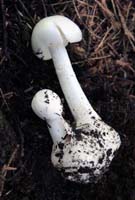 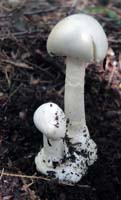 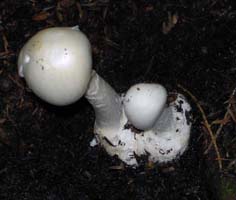
Grows single to scattered on soil in mixed hardwoods
Cap – 3.5-8 cm, convex to plane in age with a broad umbo, pure white, smooth, tacky, not striate, no volval
warts on cap, stains yellow when drop of potassium hydroxide is applied to cap
Gills – free, white, medium-broad, close to crowded
Flesh – white, medium-thick, foul odor is a bit like moth balls
Stalk – 5-12 cm x 7-15 mm, central, cylindrical, white, superior ring, sac-like bulb, pithy interior, slightly
shaggy to striate surface
Spores – white, round or nearly round, smooth, entire, amyloid, 8-12 microns
Comments – This is a DEADLY POISONOUS mushroom, never found in great quantity. Current fungi experts believe this is the American Death Angel or Destroying Angel, replacing Amanita verna and Amanita virosa, which are now considered to grow only in Europe. This grows from August to October and has been found in the Door County Land Trust Canal Property and at Whitefish Dunes State Park. |
Amanita brunnescens (Amanitaceae) Cleft Foot Amanita
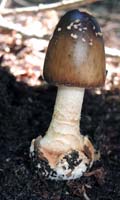 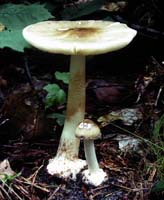
Grows single to scattered on soil in mixed woods
Cap – 5-8 cm, broadly convex, low umbo, rich chocolate brown to pale tan, margin is paler and not striate, dry, light tan volval patches
Gills – free to slightly adnexed, white, broad, close to crowded
Flesh – white, thin, firm, slight spicy fragrance or odor of radish when cut
Stalk – 6-13 cm X 6-10 mm, tapers upward, white apex and pale tan lower half, superior ring, interior is
pithy to hollow, distinct basal bulb
Spores – white, round, smooth, amyloid, 6-9 microns
Comments – This is an easy Amanita to identify because of the brown colors and several clefts in the bulb.
It grows in August and September and has been found at Ellison Bay Bluff County Park, Newport State Park, Rock Island, Whitefish Dunes State Park, Ridges Sanctuary and the Door County Land Trust Canal Property. |
Amanita citrina (Amanitaceae) Citrine Amanita

Grows on soil scattered under Eastern White Pine
Cap – 5 to 10 cm wide, convex to flat, pale yellow with flat grayish patches of universal veil
Gills – Free to narrowly attached, white, close, moderately broad
Flesh – White, medium thick, radish-like odor
Stalk – 6 to 12 cm tall by 1 to 1.5 cm wide, superior ring, bulbous base with ragged fragments of universal veil
Spore print – White
Spores – 7.5 – 10 microns, round, entire, amyloid
Comments: Found from late August to early October and is fairly common and seen every year; also found at The Ridges Sanctuary, Mink River Preserve, Whitefish Dunes State Park, Newport State Park, Washington Island and Rock Island |
Amanita frostiana (Amanitaceae) Frost’s Amanita
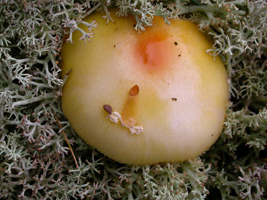 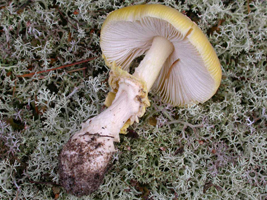
Grows on soil under conifers, sometimes in a bed of Reindeer Moss Lichen
Cap – 3 to 7 cm, broadly convex to flat, lemon yellow with orange low umbo, yellow patches of universal veil which can wash off in rainy weather, faintly striate margin
Gills – Slightly adnexed to free, cream color, close, fairly broad
Flesh – Pale yellow to orange near center
Stalk – 7 cm by 8 mm pale yellow apex to 2 cm white rather indistinct bulb, cottony pendulous median yellow ring, interior pithy becoming hollow
Spore print – White
Spores – 9-12 x 7-8 microns, entire, oval, non-amyloid
Comments: Found from early August to late October and is rather common nearly every year but never abundant; also found at Whitefish Dunes State Park, and Newport State Park. |
Amanita fulva (Amanitaceae) Tawny Grisette
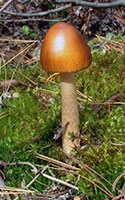 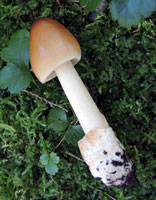
Grows widely scattered on soil in mixed woods, sometimes in moss
Cap – 3 to 6 cm, conical to broadly convex in age, milk chocolate brown, tacky, striate margin, smooth or with a few thin patches of universal veil
Gills – Nearly free to thinly adnexed, white, broad, close to crowded
Flesh – Medium thick, whitish to cream, no odor
Stalk – 8 to 15 cm, light tan to white, tapers upwards from 12 to 15 mm wide base to 5 to 9 mm apex, Florentine-like striations of medium brown over pale background
Spore print – White
Spores – 9-12 microns, round, entire, non-amyloid
Comments: Formerly known as Amanitopsis vaginata var. fulva; it is very common and fruits from mid August to mid October and can be found at The Ridges Sanctuary, Meridian County Park, Whitefish Dunes State Park, Newport State Park, Mink River Preserve and Washington Island. |
Amanita muscaria var. formosa (Amanitaceae) Fly Amanita
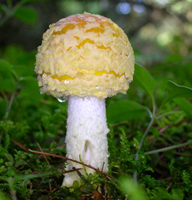 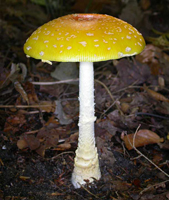
Grows gregariously on soil in the old field near spruces
Cap – 3 to 16 cm, broadly convex to flat in age, deep yellow striate margin to orange disk, yellowish to white patches of universal veil
Gills – Free, pale cream, broad, close
Flesh – White to yellowish, thick
Stalk – 12 to 16 cm by 1 to 2 cm, bulb up to 3.5 cm high by 2.5 cm wide; slimy when fresh, white to pale yellow, superior ring
Spore print – White
Spores – 9-12 x 6-9 microns, oval, entire, non-amyloid
Comments: This is a very common species seen annually from late July to mid October. Our variety never has the blood red cap of the normal Amanita muscaria. It is also found at The Ridges Sanctuary, Whitefish Dunes State Park, Newport State Park, Mink River Preserve and Washington Island. |
Amanita porphyria (Amanitaceae) Dark Booted Amanita
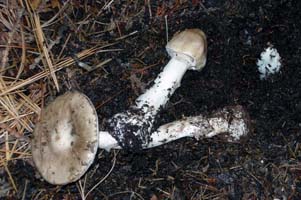  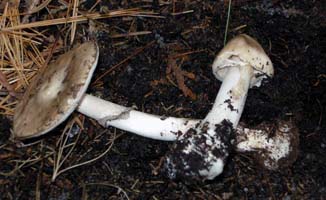 
Grows single to scattered on soil under conifers
Cap – 4-8 cm, convex to plane to slightly concave in age, gray-tan, uneven striate margin, a few flat gray volval patches, smooth, tacky to sub-viscid
Gills – free to slightly adnexed, white, close broad
Flesh – white, thin, radish smell
Stalk – 8-10 cm X 7-12 mm, tapers upward, very pale tan above the gray fragile superior ring, satin white below
ring, smooth, pithy interior, bulb is small and round, not cup-like and sheathing
Spores – white, round, smooth, amyloid, 8-10 microns
Comments – This is possibly poisonous; don’t eat any Amanitas! This is not a common mushroom. My records
show one report in 1966 again in 1987 as being found during the Clearing Folk School class. The next time I found it was in October 2013, 26 years later, at The Ridges Sanctuary! |
Amanita virosa (Amanitaceae) Destroying Angel
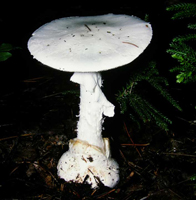 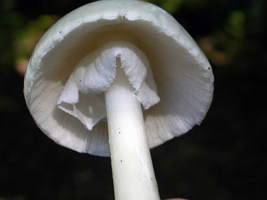
Grows scattered on soil in mixed woods
Cap – 3 to 8 cm, hemispheric to nearly flat in age, dull chalky white, smooth, slightly viscid to dry, not striate
Gills – Free to narrowly attached, white, close, broad
Flesh – White, medium thick, sometimes a pungent disagreeable odor
Stalk – 12 to 17 cm by 1 to 1.5 mm, tapers upward from a distinct bulb which is up to 3.5 cm wide and has an edge like a sac, superior membranous ring, solid to pithy interior, powdery to shaggy surface
Spore print – White
Spores – 7-12 microns, round, entire, amyloid
Comments: This is a fairly common pure white species found from mid August to late October and also seen at Meridian County Park, Mink River Preserve, Newport State Park and Whitefish Dunes State Park. |
Apiosporina morbosa (Venturiaceae) Black Knot
 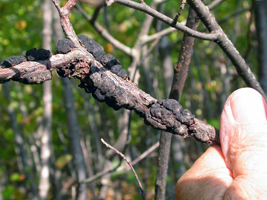
Grows scattered to clustered on living Cherry and Plum species mostly on the dead branches
Fruiting body – Spindle-shaped black rough dry knot-like growths often enclosing entire branch, hard and crusty surface
Spores – 16-22 x 5-6.5 microns, narrowly elliptical, entire, 2-celled
Comments: This parasitic species is found in many parts of the county and can be seen year ‘round. It is also known as Dibotryon morbosa. |
Armillaria bulbosa (Tricholomataceae) no common name
 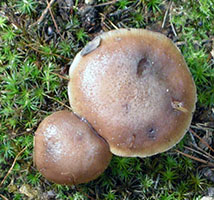 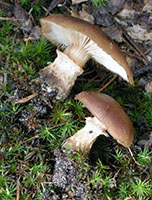
Grows single to scattered on soil or in moss
Cap – 3–6 cm, broadly convex, dull medium brown, slightly viscid to tacky, margin is slightly striate and down curved when young, disk has some tiny dark fibers but not as dense as A. mellea
Stem – 3 cm by 8–16 mm, central and bulbous, apex is narrower and light tan, base is widest and medium brown, median-superior ring flares a bit but collapses in age, pithy to hollow
Gills – decurrent, light tan, broad, close to sub-distant
Flesh – brown in cap cuticle, tan below, medium-thin, nice odor
Spores – white, non-amyloid, smooth, fat oval, 7.5-8 x 5 microns
Comments – This was found only once in late October in the Hotz Tract of Newport State Park . |
Armillaria mellea (Tricholomataceae) Honey Cap
 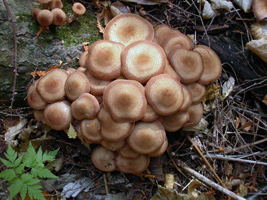
Grows on dead or dying trees and on buried roots of trees
Cap – 3 to 10 (16) cm, hemispheric to flat, light brown to rich deep brown (can be quite variable), granular surface on much of disk, margin incurved at first then uplifted in age, slimy viscid in wet weather, hygrophanous
Gills – Adnate to short decurrent, white to buff, broad, close
Flesh – White, thick, nice odor when fresh
Stalk – 4 to 8 cm by 8 to 20 mm, central, tapers upward, tough, fibrous, solid to pithy, fragile yellowish superior ring
Spore print – white
Spores – 7-11 x 4-6 microns, oval, entire, non-amyloid
Comments: This species is most variable and difficult to identify by the amateur mycologist. It often can grow in huge clusters with the bases of the stalks joined, but it can also grow as single fruiting bodies. It is found in the cold season from September into mid October and has also been seen at Meridian County Park, Mink River Preserve, Newport Park, Peninsula Park, The Ridges Sanctuary, The Clearing Folk School, Whitefish Dunes and Washington Island. It is also called Armillariella mellea and is one of Door County’s most common species. |
Armillaria tabescens (Tricholomataceae) Ringless Honey Mushroom
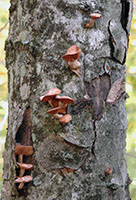 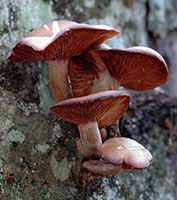 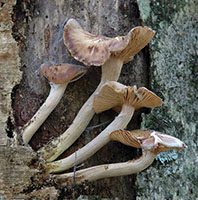
Grows in groups or cespitose clusters on dead or dying hardwoods like beech
Cap – 4-7 cm broadly convex to uplifted in age, medium brown, dry, young ones show white fibers at margin from cottony veil and not seen on older ones, margin in youth is richer brown than rest of cap and is incurved
Stem – 9-12 cm by 9-11 mm, central and curved, apex is pinkish tan and striate, fading to medium tan on lower half, tough, cartilaginous to almost woody, pithy interior
Gills – decurrent, pinkish tan, broad, sub-distant with slightly wavy margin, wrinkled deep inside to almost intervenose (may be due to crowded growth environment)
Flesh – whitish, thick, nice odor like honey caps
Spores – white, non-amyloid, fat oval, smooth, 6-8.5 x 4-5.5 microns
Comments – This was found only once in early October 2006 in Whitefish Dunes State Park; beech is now fallen and decayed
|
Ascocoryne cylichnium (Helotiaceae) Poor Man’s Licorice
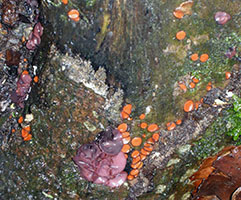 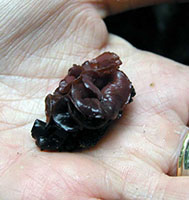 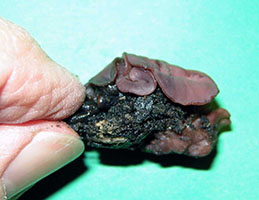
Grows clustered on well-rotted wood in low or damp places
Fruiting body – a jelly-like shallow cup or disk, 8-16 mm wide, dull purplish-maroon turning brown in age, smooth to slightly wrinkled or creased surface, underside finely pubescent, some have fused bases
Spores – white, non-amyloid, spindle-shaped, smooth, 18-30 x 4-6 microns
Comments – This was found in September to early October in Peninsula State Park and Newport State Park. It is not easy to find as it blends in with its dark damp environment.
|
Asterophora parasitica (Tricholomataceae) Silky Piggyback Mushroom
 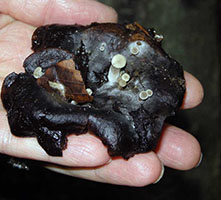 
Grows as a parasite on another mushroom, usually on the top of the Blackening Russula or Lactarius
Cap – 3-14 mm, broadly convex, light gray and satiny; no gills were seen
Stem – 1-3 cm by 1-3 mm white to pale gray
No spores were studied
Comments – Found in September at Logan Creek preserve. This is usually such a tiny mushroom that it is difficult to see any gills or to get any spores to drop.
|
Atserophora lycoperdoides (Tricholomataceae) Powder Cap
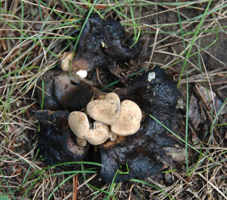
Grows clustered on very well-rotted Russula species, especially the Russula densifolia group
Cap – 1 to 2 cm, hemispheric to broadly convex, pale tan, powdery surface from spores, margin incurved
Gills – Difficult to see due to small and misshapen caps, usually thick and white, sometimes no gills form
Flesh – White, mealy odor when fresh, putrid odor when aged
Stalk – 2 to 4 cm by 4 to 7 mm, central, cylindrical, gray-white apex, gray-tan base, powdery surface
Spore print – White
Spores – 6 x 3 microns, elliptical, entire, non-amyloid
Comments: These small fruiting bodies may be difficult to see as they blend in with the dark forest floor. They are never common and appear mainly in wet years from late August into September. It is also called Nyctalis asterophora. |
Auricularia auricula (Auriculariaceae) Tree Ear or Jelly Ear
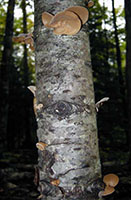 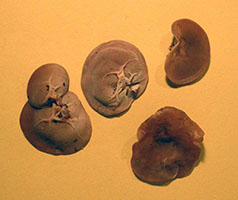 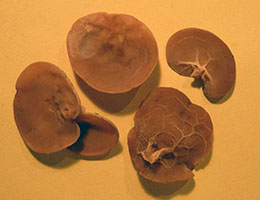
Grows scattered to gregarious on decaying conifer and hardwood trees or on fallen logs
Fruiting body – 2–4 cm diameter, round to fan-shaped, smooth top, veined underside, attached by a short point, medium yellow brown, flexible jelly-like texture
Spores – white, non-amyloid, sausage-shaped, smooth, 13-17 x 5-7 microns
Comments – This has been found at The Ridges Sanctuary, Mink River Preserve and Newport State Park from early September to early October
|
Bisporella citrina (Helotiaceae) Yellow Fairy Cups
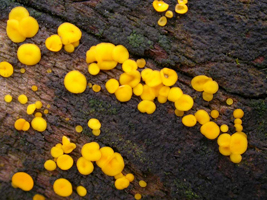 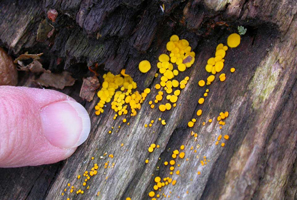
Grows in masses on barkless dead hardwood logs and stumps
Fruiting Body – smooth, shallow, yellow disks that are 1to 4 mm wide; thick base is not really a stalk.
Spores- white, but are very difficult to obtain due to its small size.
Comments – This was first seen at Whitefish Dunes State Park in September 1990. It has also been found in Peninsula State Park, Mink River Preserve, Newport State Park, Rock Island and the Nature Conservancy Kangaroo Lake Preserve |
Bjerkandera adusta (Polyporaceae) Smoky Polypore
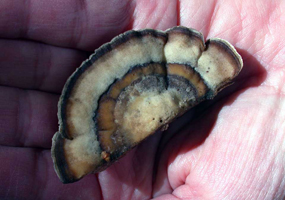 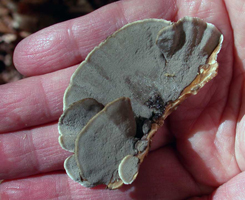
Grows fused to densely overlapping clusters on dead hardwoods
Cap – 2 to 6 cm wide by 2 to 4 cm deep, fan shaped, medium to dark brown concentric furry bands, smooth white margin; no stalk
Pore surface – Rich medium dark gray, 5 to 6 pores per mm, white sterile margin, tubes 1 to 2 mm long
Flesh – White, 1 to 3 mm thick, spongy and soft when fresh
Spore print – White
Spores – 4-5 x 2-3 microns, oval, entire, non-amyloid
Comments: This is a beautiful species when fresh and actively growing. It can be found growing from early September through October and has also been seen at The Clearing Folk School, The Ridges Sanctuary, Potawatomi Park, Mink River, Newport Park and Whitefish Dunes. |
Boletellus russellii (Boletaceae) Russell's Bolete
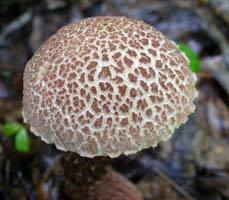 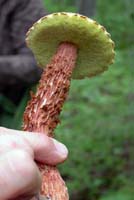
Grows single to scattered on soil under hardwoods, especially oaks
Cap – 4-8 cm, broadly convex, pale dull yellow base (cuticle), dry, areolate with medium-brown cracked raised sections; when seen through a 10 X magnifier each brown section looked like old-fashioned stacks of harvested wheat.)
Tubes – slightly depressed-attached, 1 cm deep, slight greenish-yellow hue
Pores – 1-2 per mm, yellow, angular, sterile margin of cap
Flesh – light yellow near tubes, tan-yellow near cuticle, solid, nice odor
Stalk – 10-16 cm X 1-2 cm, central, slightly curved, tapers upward, hard, longitudinally ridges with soft reddish brown shaggy plates; becomes a bit slimy in age
Spores –olive-brown, elliptical, longitudinally ridged, slight gap at apex, 15-16 x 9-11 microns
Comments – This was found in the northern part of Newport State park in July. Someone told me they had seen one in Peninsula State Park. |
Boletus affinis, var. affinis (Boletaceae) no common name
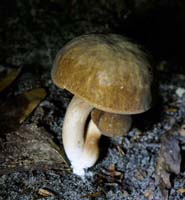 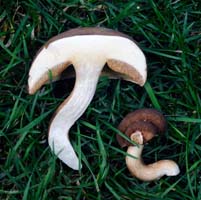 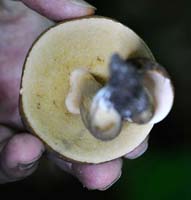
Grows scattered on soil under hardwoods, especially beech and oak
Cap – 2-6 cm, hemispheric to plane in age, milk-chocolate brown, slightly mottled, margin strait and slightly darker than disk, smooth, dry
Tubes – depressed-attached, pinkish-white when young and deep tan when mature, 5 mm deep
Pores – 1-2 per mm, round, pale pink-tan
Flesh – white, no color change when cut, very thick, bland taste
Stalk – 4-7 cm X 1-2 cm, tapers downward, central, curved, apex is slightly reticulate and mostly light to medium brown, base is white, fibrous-striate, tough, solid
Spores – rusty brown, elliptical, smooth, 9-12 x 3-4 microns
Comments – It was found only once in September 2013 at Whitefish Dunes State Park. It is also known by the name Xanthoconium affine. |
Boletus badius (Boletaceae) Bay Bolete
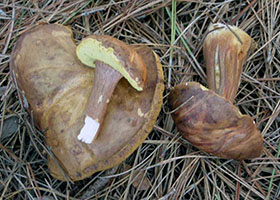  
Cap – 4–10 cm, hemispheric to broadly convex, deep orange brown to rich chocolate brown to slightly reddish-brown, slightly tacky, smooth to finely tomentose
Stem – 5–9 cm by 1-3 cm, clavate-bulbous, tapers upward, same color as cap, fibrous-striate surface, dry, tough, solid white interior
Pores – bright yellow, tiny, round, 3 per mm, bruising blue with cut or injury
Tubes – 5 mm deep, depressed-attached
Flesh – white but bruises blue near tubes when cut, no flavor, not bitter
Spores – deep brown, spindle-shaped, smooth, 10-15 x 4-6 microns
|
Boletus rubinellus (Boletaceae) Purple-red Bolete
  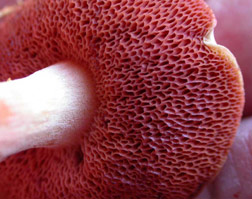
Grows solitary to scattered on soil or in moss near conifers
Cap – 3 to 6 cm, broadly convex to nearly flat in age, reddish brown disk to yellow tan near margin, fine dark appressed fibers, dry to slightly tacky when wet
Pore layer – Depressed attached to sinuate, rosy to orange brown, pores are 1 mm wide, round to slightly angular near stalk, tubes 4 to 5 mm long
Flesh – Dull yellow, very thick
Stalk – 3 to 6 cm by 8 to 10 mm, central, tapers up from a slightly bulbous base, tan with reddish brown vertical streaks, chrome yellow base and interior, solid to pithy
Spore print – Dark brown
Spores – 10-13 x 3.5-5 microns, spindle-shaped, entire, slightly roughened
Comments: This is a rare species, first discovered in Door County at Toft Point on 10-3-07. It was seen again at Toft Point on 9-15-08 and at Mink River Preserve on 9-16-08. |
Boletus rubellus (Boletaceae) Ruby Bolete
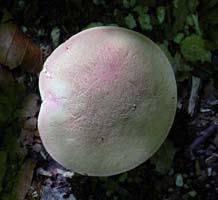 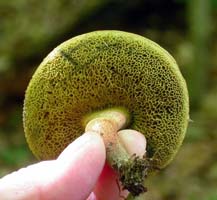 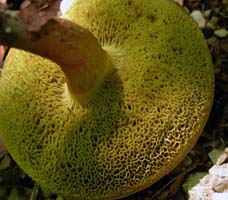
Grows single to scattered in soil under hardwoods, especially oaks
Cap – 3-6 cm, broadly convex to concave in age, medium pinkish tan, dry, slightly tomentose surface as seen with a 10 X magnifier, rose color shows where cuticle is cut
Tubes – depressed-attached, yellow-olive to dull dark yellow brown in age, up to 8 mm long
Pores – angular elongated, dull yellow, 1-3 per mm
Flesh – pale yellow-tan, medium-thick, slowly turns blue when cut
Stalk – central, curved, 3-4 cm x 4-13 mm, tapers downward, dry, pink dotted vertical lines over yellow-tan undersurface, firm, tough, becomes slightly pithy
Spores – olive brown, elliptical to spindle-shaped, entire, slightly roughened, 11-15x3.5-6 microns
Comments – This grows in August and September at Whitefish Dunes State Park. Also known as Xerocomus rubellus |
Boletus subvelutipes (Boletaceae) Red-mouth Bolete or Orange-pored Bolete
 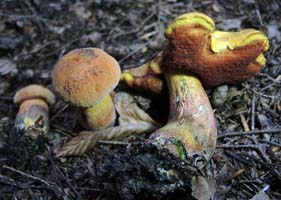 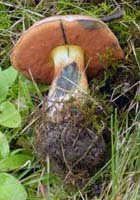  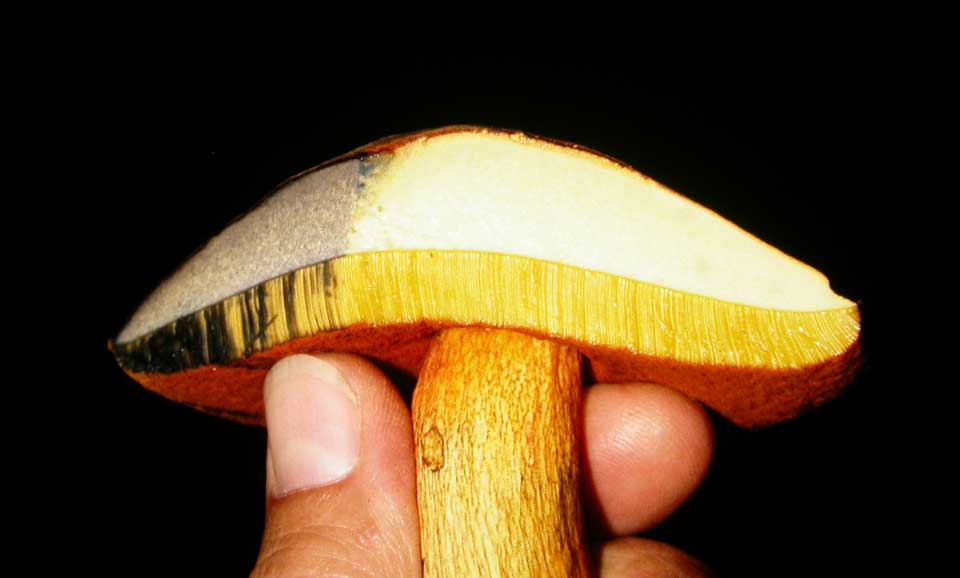
Grows single to scattered on soil in mixed hardwoods
Cap – 4-10 cm, hemispheric to broadly convex, rosy-brown to rich yellow-brown, dry, velvety, bruises with a quick color change to dark blue-gray
Tubes – depressed-attached, dull yellow, 5 mm deep
Pores – deep orange to red-orange, 2-3 per mm, bruise deep blue-gray quickly, round
Flesh – yellow turning dark blue-gray quickly when cut; medium-thick
Stalk – central, cylindrical to clavate, 5-8 cm x 1-2.5 cm, yellow-brown, smooth to slight network of fibers but not truly reticulate, solid to pithy, tough
Spores – deep brown to dark olive-brown, elliptical to football-shaped, smooth, 12-16 x 5-8 microns
Comments – This is a poisonous species that grows from July to September. It has been found in the Mink River Preserve, Logan Creek Preserve, Rock Island and the Clearing School woods. |
Bulgaria inquinans (Bulgariaceae) Black Jelly Drops
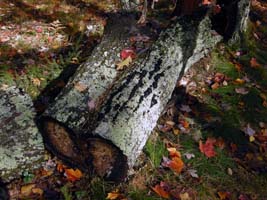 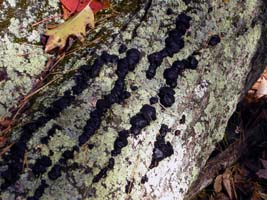  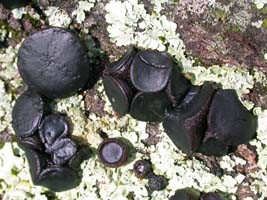
Grows in joined masses on the bark of fallen dead oak trees
Fruiting Body – 1-4 cm wide, black, smooth, rubbery, top-shaped to slightly concave and contorted, average size is 1.5 cm thick, under-surface has pebbly texture
Central basal attachment is 5 mm wide but is not a true stalk
Spores – black, spindle-shaped to kidney-shaped, smooth, 11-15 x 5-7 microns
Comments – Found for the first time in October 2012 in the north end of Newport State Park; also known by the name Phaeobulgaria inquinans. |
Calocera cornea (Dacromycetaceae) Club-like Tuning Fork
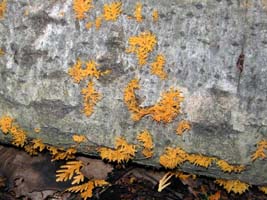 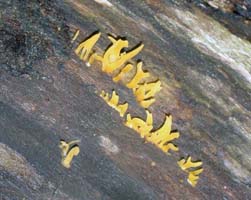 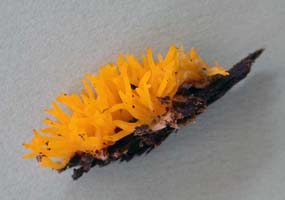
Grows in scattered groups on hardwood logs, some with bark and others without bark
Fruiting body – 7-10 mm tall by 1 mm wide, yellow to yellow-orange, round with bluntly pointed tips and wider flat base; some have tiny tip branching. It looks like a small coral but is actually a jelly fungus.
Spores – buff, elliptical to sausage shape, smooth, 7-11 x 3-4.5 microns
Comments – grows in September and October and has been found at Whitefish Dunes State Park and Three Springs Preserve. A similar species, Calocera furcata, can be found on dead conifers. |
Grows in scattered groups on hardwood logs, some with bark and others without bark
Fruiting body – 7-10 mm tall by 1 mm wide, yellow to yellow-orange, round with bluntly pointed tips and wider flat base; some have tiny tip branching. It looks like a small coral but is actually a jelly fungus.
Spores – buff, elliptical to sausage shape, smooth, 7-11 x 3-4.5 microns
Comments – grows in September and October and has been found at Whitefish Dunes State Park and Three Springs Preserve. A similar species, Calocera furcata, can be found on dead conifers.
Calvatia gigantea (Lycoperdaceae) Giant Puffball
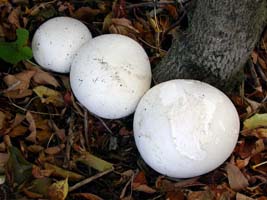 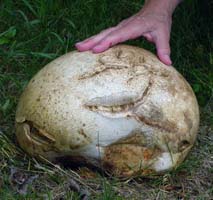 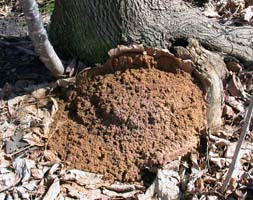 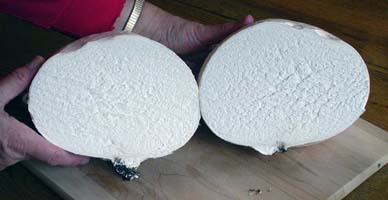
Grows single to scattered in grassy areas or in sandy soil
Fruiting body – 10 to 11 cm tall, 11 cm wide, a flattened ball with a narrower basal section in age, outer surface tan to light brown, cracking lines develop in age, interior white to brown to purple brown as spores mature, base is partly hollow and a separate texture from upper part, stalk up to 6 cm wide
Spores – purple-brown, round, spiny, 3.5-6 microns
Comments – This is a rather rare species and has only been seen once in mid-August of 1999 near “Old Baldy” in Whitefish Dunes State Park.
|
Calvatia cyathiformis (Lycoperdaceae) Purple-spored Puffball
 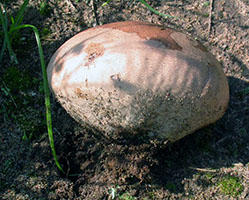 
Grows single to scattered on soil or grass in mixed hardwoods and in meadows
Fruiting body – 15-50 cm (6 to 20 inches), round, white, kid-skin leather-like surface cracking in age, attached to ground by a short “root-like” extension, skin peels easily when fresh; interior pure white when fresh.
Spore mass develops as it ages and turns brown, large cracks opening outer skin and interior becomes slimy and foul-smelling
Spores – olive brown, round, minutely spiny, 4-5 microns
Comments – found in many areas but mostly on private properties from early July to October. |
Camarophyllus cinereus (Hygrophoraceae) Violet-gray Waxy Cap
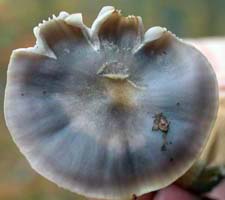 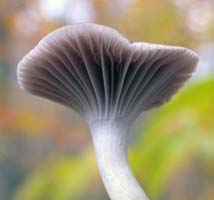 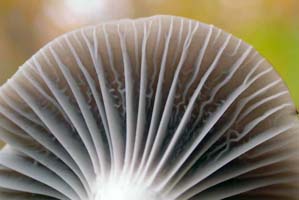
Grows single on soil in mixed woods
Cap – 3-4 cm, purplish-brown, broadly convex to plane with faint umbo, not viscid, margin is striate and slightly uplifted in age and splits, hygrophanous
Gills – decurrent, medium-gray, broad, intervenose, sub-distant
Flesh – thick, grayish
Stalk – 3-4 cm x 5-9 mm, tapers downward, dry, dull sheen, interior becomes pithy
Spores – white, elliptical, smooth, not amyloid, 7-11 x 4-6 microns
Comments – found only once in October on private land |
Cantharellus cibarius (Cantharellaceae) The Chanterelle
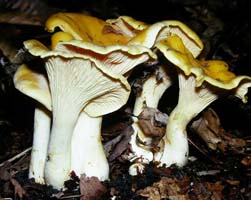  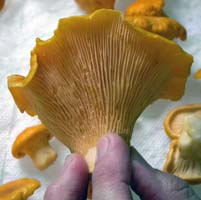 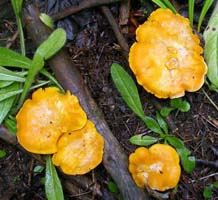
Grows single to scattered on soil in mixed woods
Cap – 3-15 cm, deep yellow, very broadly convex to plane and concave in age, smooth
Gills – decurrent, yellow, blunt, narrow, some forking to intervenose
Flesh – concolor, thick, odor like apricots
Stalk – 2-5 cm x 1-2 cm, concolor, smooth, solid, tapers downward, bruises orange-brown in age
Spores – pale yellow, elliptical, smooth, not amyloid, 8-11 x 5-7 microns
Comments – grows from July to September and has been found in Peninsula State Park, Kangaroo Lake Preserve, Rock island, Logan Creek Preserve |
Cantharellus minor (Cantharellaceae) Small Chanterelle
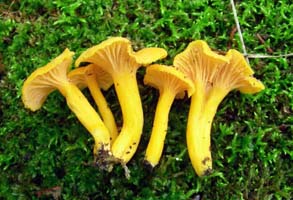 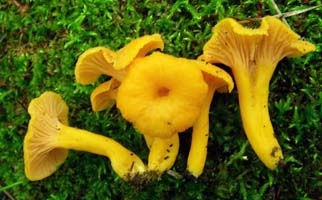
Grows in clusters on soil or moss in mixed hardwoods
Cap – 2-3 cm wide, very broadly convex to funnel-shaped with a hole in the center, deep yellow, hygrophanous, smooth to finely fibrillose
Gills – decurrent, distant, concolor, blunt, shallow
Flesh – thin, concolor
Stalk – 2-3 cm x 3-8 mm, central, cylindrical, tubular, smooth, concolor, tapers downward
Spores – white, non-amyloid, elliptical, smooth, 10-13 x 6-8 microns
Comments – found in September on Rock Island |
Cantharellus tubaeformis (Cantharellaceae) Trumpet Chanterelle
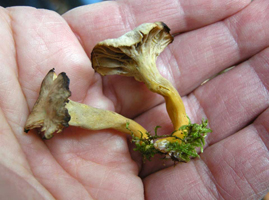
Grows scattered in moss and humus or on rotting conifers
Cap – 2 cm, flat to funnel shape, dull tan, widely spaced clumps of fibers on surface, dry, hygrophanous
Gills – Decurrent, tan, very widely spaced and intervenose, blunt edges
Flesh – Pale olive yellow, very thin
Stalk – 2 cm by 5 mm, tan apex, flexuous, chrome yellow base, smooth to finely tomentose near apex, hollow
Spore print – White
Spores – 7-11 x 6-7 microns, nearly round, slightly roughened, non-amyloid
Comments: This species may be more common than reported because it is small and difficult to see. It can be found in September and October and has also been seen at the Logan Creek Preserve and Mink River. |
Cantharellula umbonata (Tricholomataceae) Grayling
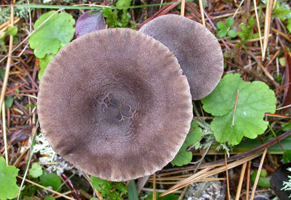 
Grows solitary to widely scattered on soil or moss under conifers
Cap – 1 to 3 cm, very broadly convex to flat with small pointed umbo, medium gray, incurved tomentose margin, not hygrophanous, striate nor viscid
Gills – Decurrent, white, close, all forked at least once, narrow
Flesh – Light gray, thick, nice odor
Stalk – 3 to 6 cm by 3 to 7 mm, narrower at base, flexuous, very pale gray, fibrous, pithy with cartilaginous rind
Spore print – White
Spores – 9-13 x 3-5 microns, long-elliptical, entire, amyloid
Comments: This species likes to grow in Haircap Moss and is never abundant. It is easily recognized by the pointed umbo on a usually flat silvery gray cap. It can be found in September and October and has also been seen at Whitefish Dunes State Park. |
Cantharellus xanthopus (Cantharellaceae) Yellow Foot
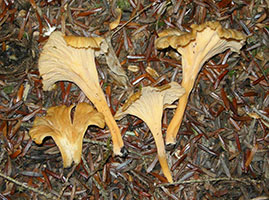 
Grows scattered to gregarious on well-rotted wood and on soil in low damp mixed woods
Cap – 1.5-6cm, broad funnel shape, light orange, thin ragged margin, brown fibers on part of top
Stem – 2-5 cm by 2-5 mm, central to off-center, dull medium orange-yellow, smooth to slightly grooved, tapers downward, hollow and brittle
Gills – concolor, no true gills, wrinkled surface, light orange
Flesh – nearly none
Spores – white, non-amyloid, elliptical, smooth, 9-11 x 5-8 microns
Comments – This small species is found from late August to early October in The Ridges Sanctuary, Toft Point and Logan Creek Preserve.
|
Cerrena unicolor (Polyporaceae) Furry Maze Polypore

Grows in overlapping clusters on fallen hardwood trees and stumps
Fruiting body – 3-6 cm wide by 2-3 cm deep, top surface very furry, gray but turning green in age with algae covering it, margin is ruffled, wavy and white. It is very thin, leathery and up to 2 mm thick.
Pore surface – beige to gray, pores 3 to 4 per mm, becoming labyrinth and slightly toothed, pore layer is 1-1.5 mm thick
Spores – colorless, elliptical, smooth, non-amyloid, 4-6 x 3 microns
Comments – This is a difficult species to identify due to its drying out quickly and becoming coated with green algae in age. It grows from July to September and has been found in Peninsula State Park, Whitefish Dunes State Park and Washington Island. |
Chlorociboria aeruginascens (Helotiaceae) Blue-green Stainer
 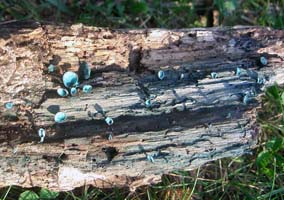 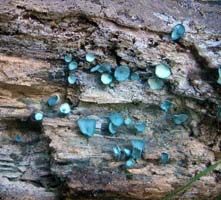
Grows scattered on blue-green stained dead hardwood that has lost its bark
Fruiting body – 5-10 mm wide and tall, blue-green, partial flattened funnel shaped, smooth, thin-fleshed
Spores – colorless, non-amyloid, smooth cylindrical, 6-9 c 1.5 microns
Comments – The fruiting bodies were found in September and October but not nearly as often as the pieces of blue-green stained wood is seen. It has been found in the Mink River Preserve, Newport State Park, Peninsula State Park, the Ridges Sanctuary, and the Clearing School woods. A similar species, Chlorociboria aeruginosa, has smaller spores. |
Chondrostereum purpureum (Stereaceae) Silver leaf Fungus
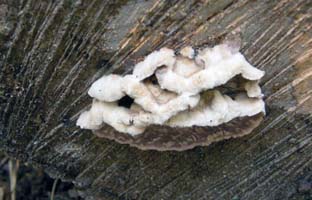 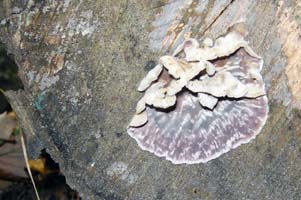
Grows on dead or dying hardwood logs and stumps and on apple and plum trees, causing silver leaf damage to the trees, eventually killing them.
Fruiting body – average 4cm x 1.5 cm, white to tan above with purple colors on the underside, resupinate-reflexed growth pattern with upper part having a furry top surface and the underside purple surface smooth but contorted, margin can be undulating
Spores – clear, non-amyloid, elliptical, smooth, 5-6 x 3 microns
Comments – This was first seen in October in a land Trust preserve in central northern Door Co. |
Clavaria vermicularis (Clavariaceae) White Worm Coral
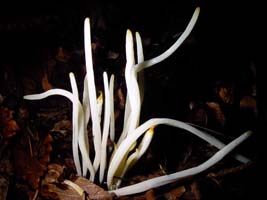 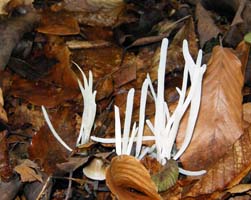 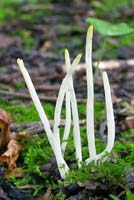
Grows single to clustered on soil in open mixed woods
Fruiting body – 5-11 cm tall by 2-4 mm wide, white, smooth, round-tipped that turn light yellow in age, brittle, sometimes with a long vertical groove in center, un-branched
Spores – white, non-amyloid, elliptical, smooth, 4.5-6 x 3-4 microns
Comments – grows from July to September and has been found at Newport State Park, Logan Creek Preserve and Washington Island |
Clavariadelphus ligula (Clavariaceae) Strap Coral
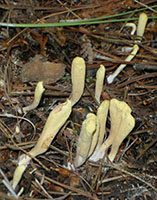 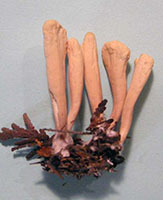
Grows scattered to gregarious on sandy soil in mixed conifer woods
Fruiting body – upright round-tipped clubs, 3 to 8 cm tall by 3 to 11 mm wide, stems are 3-4 mm wide and slightly darker near base, top is slightly wrinkled, dull yellow-tan, dry, inside is white and cottony compared to outer rigid shell
Spores – white, non-amyloid, spindle-shaped, smooth, 12-15 x 3.5-4.5 microns
Comments – These have been seen from early September to mid-October and were found in private woods and at the Ridges Sanctuary. |
Clavariadelphus truncatus (Clavariaceae) Flat-topped Club Coral
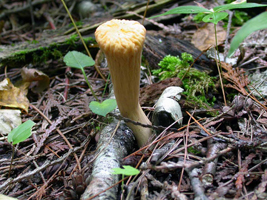 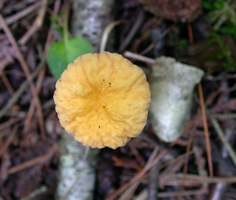 
Grows single to widely scattered on soil in mixed woods
Fruiting body – 7 to 10cm tall, fertile top portion 6cm long with vertical wrinkles, dull medium yellow, flat top is 2 to 3cm wide, wrinkled, brighter yellow than sides
Basal section – 3 to 4cm long by 2cm wide, gray-tan, smooth
Interior – white to pale yellow, moist, soft, pithy
Spore print – pale buff
Spores – elliptical, non-amyloid, smooth, 8-11x5-7 microns
Found from August to September. Also seen in Ephraim upland woods in 1982; last seen in September 1984!
|
Clavulina cinerea (Clavariaceae) Ashy Coral Mushroom
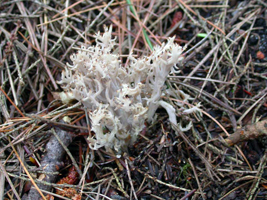
Grows as single cluster on soil in mixed woods
Fruiting body – 5 to 6cm tall, 3 to 4cm wide at top, ashy gray, tips very pointed and darken with age, each branch is about 2mm wide & hollow
Base – white with many joined branching units
Spore print – white
Spores – fat elliptical, non-amyloid, smooth, 7-9x5-8 microns
Found from August to September. |
Clavulina cristata (Clavariaceae) Crested Coral
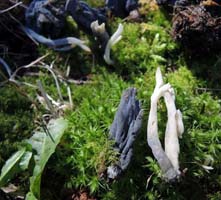 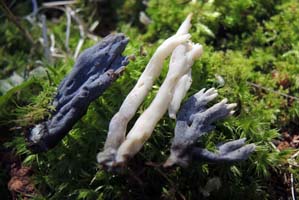
Grows single to scattered on soil and moss in mixed woods
Fruiting body – 6-7 cm tall by 4-6 cm wide, white with dark gray base, contorted tops are many-branched with a few blunt tips, base is 1-1.5 cm thick
Spores – white, non-amyloid, fat oval, smooth, 9-11 x 6-7.5 microns
Comments – This is one of a couple white branched corals that can be parasitized by a dark gray fungus which makes it difficult to identify. It grows in September and October and has been found at Newport State Park and at Whitefish Dunes State Park.. It is also known as Clavulina coralloides. The mold that grows on this is called Helminthosphaeria clavariarum. |
Clavulinopsis corniculata (Clavariaceae) Yellow Branched Coral
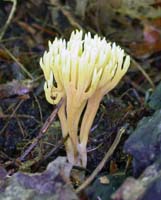 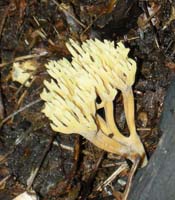
Grows single to scattered on soil in mixed woods
Fruiting body – 3-7 cm tall, stalk section is 2 cm long by 2-3 mm wide, multi-branched with a few having 2 tips, branched top is light yellow, mid part is dull yellow-tan and base is white.
Spores – white, non-amyloid, round, smooth, 4-7 microns
Comments – This has been seen in September at The Ridges Sanctuary and on Washington Island. |
Clavulinopsis fusiformis (Clavariaceae) Tall Yellow Coral
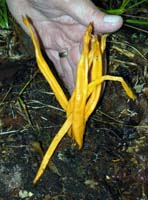 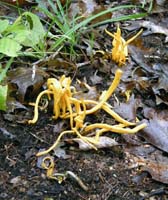
Grows scattered to gregarious on soil in mixed woods
Fruiting body – 6-14 cm tall by 1-1.5 cm wide, bright yellow, long vertical groove, twisted, smooth, hollow
Spores – white, non-amyloid, round, smooth with a pronounced apiculus, 7-9 microns
Comments – It grows in August and September and has been found at Newport State Park and on Rock Island |
Clavulinopsis laeticolor (Clavariaceae) Golden Fairy Club
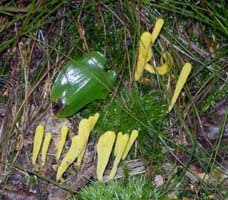 
Grows scattered to gregarious on soil in mixed woods
Fruiting body – 2-6 cm tall by 3-5 mm wide, deep yellow, smooth, round-tipped, slightly flattened and longitudinally wrinkled and grooved, unbranched, tapers downward
Spores – white, non-amyloid, round to oblong or pear-shaped, 5-7.5 x 4-6 microns
Comments – It grows in September and October and has been found at Whitefish Dunes State Park, the Ridges Sanctuary, Rock Island, Washington Island and Logan Creek Preserve. It is also know by the names Clavulinopsis pulchra and Ramariopsis laeticolor. |
Climacodon septentrionale (Meruliaceae) Overlapping Toothed Polypore
 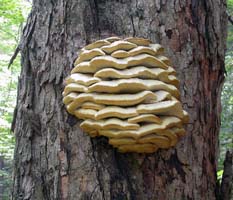 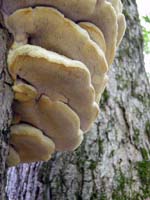 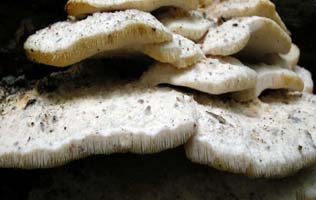
Grows in shelving layers on living or recently fallen hardwoods, especially maple & beech
Fruiting body – 20-30 cm wide by 8-16 cm deep, 3-5 cm thick, soft, white, overlapping layers, top surface furry or matted wooly
Teeth – up to 2 cm long, pale tan, fragile
Flesh – 12 – 15 mm, thick, pale tan
Spores – white, non-amyloid, elliptical, smooth, 4-6 x 3 microns
Comments – This sometimes grows high on the side of a standing tree and is impossible to examine, but I have found some on recently fallen trees that were accessible. It grows from August to October and has been found at Whitefish Dunes State Park, Logan Creek Preserve, Newport State Park and the Mink River Preserve. I have seen one in late winter and it turned completely black 6 months after fresh growth. It is also known by the name Steccherinum septentrionale. |
Clitocybe clavipes (Tricholomataceae) Club Foot
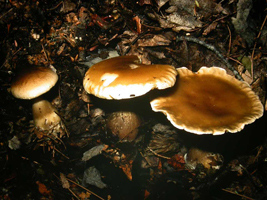 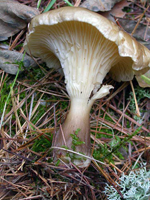
Grows solitary to cespitose or widely scattered on soil in mixed woods
Cap – 3 to 7 cm, nearly flat to funnel shape, margin down-curved then uplifted in age, grayish-brown, dull sheen, smooth to faintly striate, dry
Gills – Adnate to decurrent, pale tan, medium broad, close
Flesh – White to light tan, medium-thick, foul odor in age like cherry or peach pits
Stalk – 3 to 5 cm by 5 to 10mm at apex and 9 to 24 mm at basal bulb, tan to medium brown, smooth, pithy to hollow
Spore print – White
Spores – 6-8 x 3-5 microns, long oval, prominent apiculus, entire
Comments: This is easily identified because of its extreme bulbous base which tapers up to a much narrower apex. It is fairly common but never abundant and can be found from late July to late October. It has also been seen at The Ridges Sanctuary, Whitefish Dunes and Washington Island. |
Clitocybe gibba var. maxima (Tricholomataceae) Large Funnel Cap
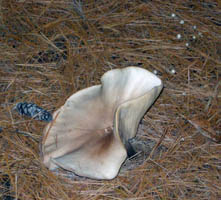   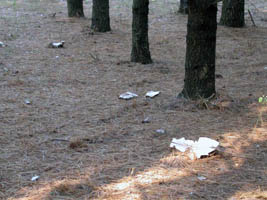
Grows scattered or in large arcs on soil under pines
Cap – 15-21 cm, light tan margin to medium pinkish tan center, smooth, plane to broadly concave
Gills – Adnate to short-decurrent or slightly notched, tan, close to crowded, broad
Flesh – very thick, white, slight acrid odor
Stalk – central, cylindrical, 7 cm x 2.5 cm, medium to dark brown, vertically streaked, very tough and cartilaginous, becoming pithy
Spore print – White
Spores – Elliptical, smooth, non-amyloid, 8-11 x 4.5-5.5 microns
Comments: Last found at Toft Point on 10-2-75. |
Clitocybe gigantea (Tricholomataceae) Giant Clitocybe
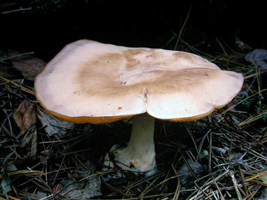
Grows solitary or in large fairy rings on soil in open mixed woods
Cap – 10 to 40 cm, broadly convex to flat, white to buff, pinkish-tan in the maxima group of C. gibba
Gills – Decurrent, crowded, white to buff
Flesh – White
Stalk – 3 to 10 cm by 2 to 4.5 cm, white, solid, dry
Spore print – White
Spores – 6-8 x 3-4.5 microns, elliptical, entire, weakly amyloid
Edibility – Not recommended
Comments: This species has rarely been seen at Toft Point. The only records are from 10-2-75 with a Clearing class and September 1976 with a Clearing class. No details of the findings were noted. We have no other records in Door County. Some mycologists put it in the genus Leucopaxillus due to its weakly amyloid spores. |
Clitocybe inversa (Tricholomataceae) no common name
<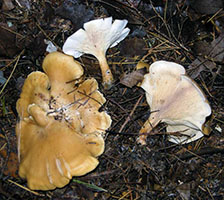 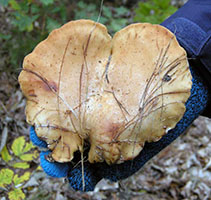 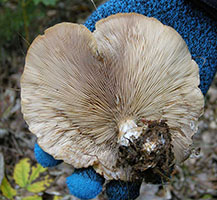
Grows scattered in grass along wooded trails
Cap – 6 to 12 cm, very broadly convex to plane and slightly concave in age but not a true funnel, medium orange brown, tacky (grass sticks to cap) margin incurved in young and is undulating in age
Stem – 5-5 cm by 1-2 cm, central to off-center and contorted in age, apex narrower, tan, cartilaginous, stuffed to pithy, orange interior
Gills – short decurrent, tan, close to crowded, broad
Flesh – concolor with cap
Spores – white to pale buff, non-amyloid, fat oval, tuberculate, 4-5.5x3.5-4.5 microns |
Clitocybe nuda (Tricholomataceae) Blewit
  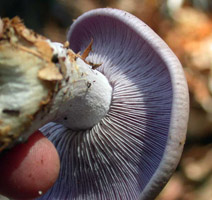
Grows scattered to gregarious and in fairy rings on soil in mixed woods
Cap – 3 to 12 cm, hemispheric to broadly convex to nearly flat in age, light pinkish-purple to light tan, margin incurved at first to uplifted in age, smooth to minutely tomentose, slightly viscid when fresh
Gills – Sinuate, pinkish-tan to pale violet, close to crowded, narrow
Flesh – Pale violet, thick, nice odor
Stalk – 3.5 to 6 cm by 1.5 to 2.2 cm apex and 2 to 4.5 cm bulbous base, light violet, striate, solid
Spore print – Pinkish-buff
Spores – 5-8 x 3-5 microns, elliptical, minutely roughened
Comments: This species is not very common being seen every few years from late July to mid October. It has also been seen at Newport Park and Whitefish Dunes. |
Clitocybe robusta (Tricholomataceae) no common name
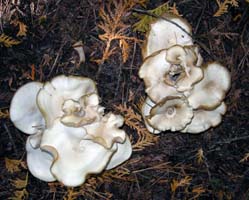 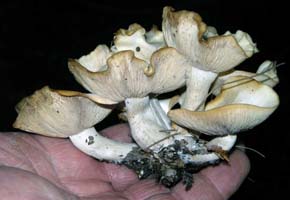 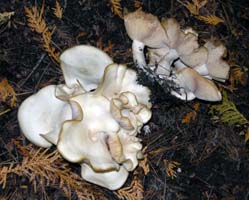
Grows scattered to gregarious on soil or grass in mixed woods
Cap – 5-17 cm, broadly convex to concave in age, white to tan, finely fibrillose to smooth, dry, margin wavy
Gills – adnate to short decurrent, tan, close to crowded, narrow to medium-broad
Flesh – thick, white to off-white, bad odor
Stalk – 5-8 cm x 1-5 cm, central, cylindrical, tan, slightly striate, slightly bulbous, solid
Spores – buff, non-amyloid, elliptical, smooth, 6-9 x 3.5-5 microns
Comments – It grows in September and October and has been found on several private properties and at Three Springs Preserve. |
Clitocybe subclavipes (Tricholomataceae) no common name
 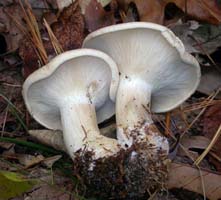
Grows single to cespitose on soil in mixed conifer woods
Cap – 5-7 cm, very broadly convex to plane, light to medium yellow-tan, faintly tomentose, low umbo, down curved margin, has a dry chalky appearance and is slightly viscid to tacky
Gills – slightly decurrent, pale tan, close to crowded, narrow
Flesh – white, thick
Stalk – 6 cm x 1.5 cm, central, slightly clavate, gray to pale tan, solid white interior
Spores – white, non-amyloid, elliptical, smooth, 5-6 x 3 microns
Comments – The first and only time it was seen was in October 2011 in the northern part of Newport State Park |
Clitocybula ocula (Tricholomataceae) no common name
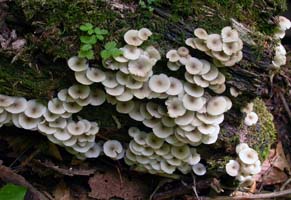 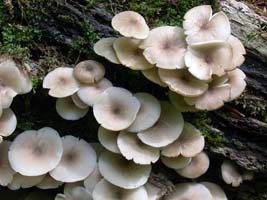  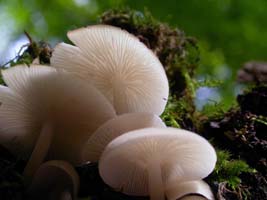
Grows clustered to gregarious on rotting hardwoods
Cap – 2-2.5 cm, convex but soon slightly umbilicate, light brown fading to pale gray-tan with darker center, dry, thin margins
Gills – short decurrent, medium-broad, close to sub-distant, whitish
Flesh – thin, pale tan, no distinct odor
Stalk – 4 cm x 2-3 mm, central, slightly curved, pale gray-tan, hollow, smooth
Spores – white, amyloid, smooth, round to fat oval, 4.5-6 (7.5) microns
Comments – This was seen only once in August 2012 at Whitefish Dunes State Park on a rotting maple tree. The former name was Clitocybe ocula. This needs more study. It might be Clitocybula abundans, instead. |
Collybia acervata (Tricholomataceae) Clustered Collybia
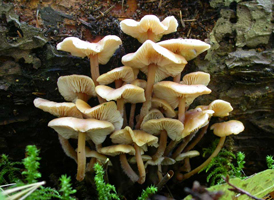 
Grows densely clustered low on well rotted conifers
Cap – 2-3.5 cm, very broadly convex, light to medium tan, smooth, not striate or viscid
Gills – Adnexed, pale tan, close, broad
Flesh – Orange-tan, thin
Stalk – 7 to 9 cm by 3 to 5 mm, light tan to medium brown, central but curving, terete, smooth but some have tufts of hairs at base, cartilaginous, pithy to hollow
Spore print – White
Spores – 6-7.5 x 2.5-3 microns, entire, elliptical, non-amyloid
Comments: This species is now called Gymnopus acervatus by some authors. It has only been seen once at Toft Point on 10-3-2007 and not recorded at any other Door County location. |
Collybia butyracea (Tricholomataceae) Buttery Collybia
 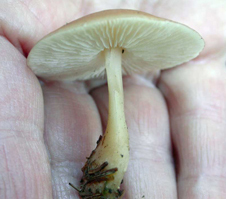 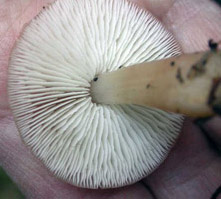
Grows solitary to widely scattered on soil in mixed woods
Cap – 2.5 to 3.7 cm, very broadly convex, medium orange-brown, hygrophanous, slightly striate, smooth
Gills – Adnate-emarginate to sinuate, white to pale buff, close to crowded, broad, eroded to faintly ragged edges
Flesh – Pale to medium tan, medium-thick
Stalk – 3 to 5 cm by 3 to 15 mm, light tan, tapers upward, central, terete, smooth, dry, pithy to hollow
Spore print – White to pale buff
Spores – 5-8 x 3-4 microns, oval, entire, dextrinoid
Comments: This species can look like so many other brown mushrooms. It is never abundant and has only been recorded at Toft Point on 10-3-2007. It has also been seen at Newport State Park and Whitefish Dunes.
|
Coltricia cinnamomea (Polyporaceae) Fairy Stool
  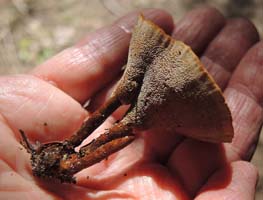
Grows single to scattered on soil or moss in mixed hardwoods
Cap – 1.5–4 cm, concave to shallow funnel, zonate bands of dark brown and medium orange-brown with a hologram-like sheen, dry, long matted fibers seen with a 10 X magnifier
Tubes – adnate to decurrent, dark brown, 1-2 mm deep
Pores – deep brown to gray-brown, round, 3 per mm
Flesh – thin, dark rusty brown, 1 mm thick
Spores – brown, elliptical, smooth, 6-8 x 4-5.5 microns
Comments – Grows from July to October and has been found at Whitefish Dunes State Park, Meridian County Park, Door County Land Trust Canal Property and Rock Island |
Coltricia perennis (Polyporaceae) Tan Fairy Stool
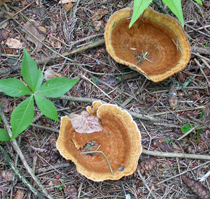  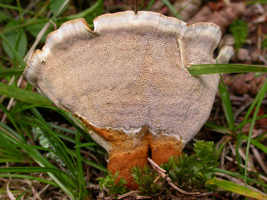
Grows scattered on soil under conifers
Cap – 3 to 12 cm, concave to funnel shape, zonate, dry velvety concentric bands of medium orange brown, paler margin, some funnels have half-circle caps growing inside, hygrophanous
Pore surface – Slightly decurrent, gray-tan to medium gray brown, very pale tan at margin, pores 1 to 2 per mm, not round, irregular shape, tubes 1 to 3 mm long
Flesh – Brown, thin, zoned, dry, tough
Stalk – 2 to 3 cm by 2 to 3 mm, medium yellow brown to rich cinnamon brown, soft, dry, tomentose
Spore print – Pale brown; difficult to get spores to drop.
Spores – 6.5-8.5 x 3.5-5 microns, oval, entire
Comments: This uncommon species grows from early August to late September. It has also been seen at Newport Park and Whitefish Dunes State Park. |
Coniophora puteana (Coniophoraceae) Wet Rot
 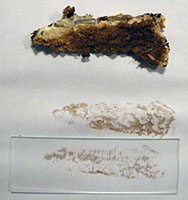
Grows like a crust fungus on either standing or fallen decaying hardwoods
Fruiting body – fairly thin spreading medium brown bumpy main section with white finely furry border, 4 to 7 cm or larger
Spores – brown, elliptical, roughened but entire, 12-15 x 7-9 microns
Comments – First seen in mid-October in Newport State Park
|
tr>
Coprinopsis atramentaria (Psathyrellaceae) Alcohol Ink Cap
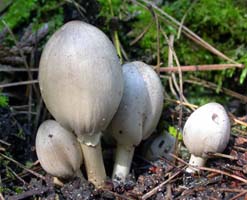  
Grows single to densely clustered on lawns, disturbed ground and on soil in mixed woods, generally from buried wood or tree roots
Cap – 1.5-3.5 cm tall by 3-6 cm wide, orbicular, gray-tan, smooth, dry, striate
Gills – adnexed to nearly free, very broad, light gray to black in age, very crowded
Flesh – thin to nearly none, light to dark gray, no odor
Stalk – 7-10 cm x 5-14 mm, central, cylindrical, white to pale gray apex and pale tan base, smooth, hollow, brittle, faint inferior ring seen in very young fruiting bodies
Spores – dark brown to black, oval, truncate by apical pore, smooth, 8-10 x 5-6 microns
Comments – The Alcohol Ink Cap name refers to a poisonous reaction if this is eaten within 72 hours (three days) of consuming an alcoholic beverage; not deadly but can make one very sick. It grows from July to November and has been found on lawns at many private homes and at Newport State Park and Logan Creek Preserve. It was formerly called Coprinus atramentarius. |
Coprinopsis lagopus (Psathyrellaceae) Wooly Ink Cap
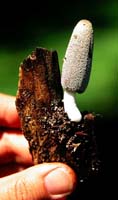 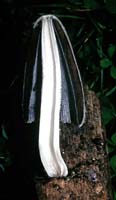 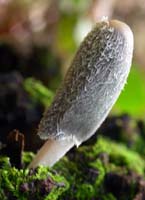
Grows single to scattered or gregarious on rotting wood in mixed woods
Cap – 2-4 cm tall by 1-1.5 cm wide, columnar becoming nearly plane in age and spreading to 4-5 cm wide, young are gray-tan covered with white wooly hairs which rub off easily, mature are medium-dark gray, plicate-striate, margin flares up and splits
Gills – adnexed to free, medium-broad, close to crowded, gray, turning inky in wet weather
Flesh – pale gray, very thin
Stalk – 5-10 cm x 3-10 mm, central, cylindrical, white to pale gray, when young it is hairy like cap, tapers upward, hollow, base covered with villose white hairs
Spores – black, elliptical, smooth, apical pore, 11-14 x 6-7.5 microns
Comments – grows from late August to early October and has been found at Peninsula State Park, Whitefish Dunes State Park and Rock Island. This species does not liquefy as rapidly as others. |
Coprinopsis picacea (Psathyrellaceae) Magpie Mushroom
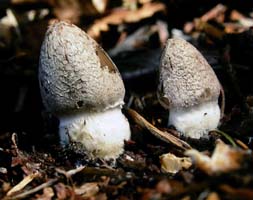  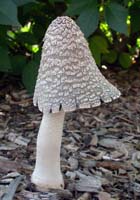 
Grows scattered to gregarious on wood chip mulch
Entire fruiting body is 10 to 16 cm tall.
Cap – 4-7 cm x 3-5 cm, gray-brown, striate with pale tan floccose covering, bell-shaped in age
Gills – nearly free, very pale gray, turning black in age, broad, crowded, turning inky in age
Flesh – thin, gray, soft, smells like mothballs
Stalk – 9-15 cm x 5-15 mm, central, cylindrical, tapers upward, very pale tan, hollow slight bulbous base, smooth
Spores – black, elliptical, smooth, 13-19 x 8-11 microns
Comments –It is possibly poisonous. I first saw this on wood chips near the Ridges Sanctuary Nature Center on 10-21-90, and again in September 1993. Then in September 2005 & 2006 many were found on thick wood chip mulch at a home near Lake Michigan. This is not in any Midwest mushroom field guides. I used David Arora’s Mushrooms Demystified book to identify it. They like to grow near beech trees in Europe and it is thought they like alkaline soil. I suspect the wood chips on which they were growing had been imported from the west coast of America which is the home of David Arora and is also where Magpies are common. |
Coprinopsis variegata (Psathyrellaceae) Scaly Ink Cap
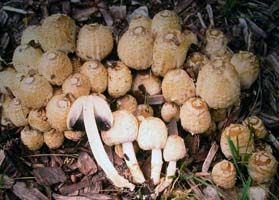 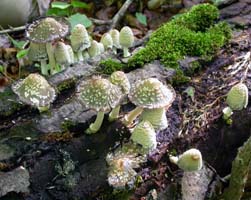 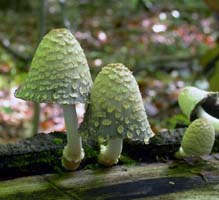 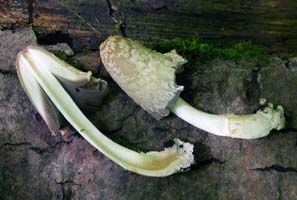
Grows in dense cespitose clusters on dead hardwood logs and wood chip piles
Fruiting body is 4 to 7 cm tall.
Cap – 2-4 cm tall by 2-5.5 cm wide, oval shape in youth expanding to bell shape with a revolute margin in age, tan with thick yellow-brown fragmented scales, striate, dry
Gills – adnexed to nearly free, white when young to tan and then blackening in age, broad, crowded
Flesh – none
Stalk – 4-10 cm x 4-10 mm, central, cylindrical, white apex is pruinose, rest is white to light tan and fibrous-striate, inferior tan ring clings to stalk, hollow
Spores – black, elliptical, smooth, apical pore, 7-10 x 4-5 microns
Comments – I first found this in June 1996 on a wood chip pile at a friend’s home; grows from late June to September and has been found at Peninsula State Park and at Newport State Park. Other names are Coprinus ebulbosus, Coprinus quadrifidus and Coprinus variegatus |
Coprinus comatus (Coprinaceae) Shaggy Mane
 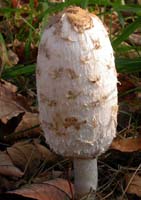 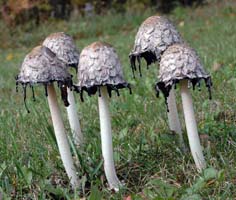 
Grows scattered to gregarious on lawns and along roadsides
Cap – 4-12 cm tall by 2-4 cm wide, oval to cylindrical, expanding to bell shape before dissolving into black ink, young have a smooth tan disk with the rest white coated with shaggy clumps of tan fibers
Gills – adnexed to free, very crowded, very broad, white then changing to pink and gray and then black ink
Flesh – white and very thin to nearly none
Stalk – 6-15 x 1-2 cm, central, cylindrical, white, smooth, hollow, brittle, tapers upward, partial ring often clings to cap margin
Spores – black, elliptical, smooth, large apical pore, 8-13 x 5-8 microns
Comments – Edible when very young before any color change. Not edible when turning ping and gray. They need to be cooked right after picking as the caps will turn to ink even in the refrigerator. Grows from August to October and has been seen in many areas of Door County often just along roads. This is one of the most recognizable of the wild mushrooms. |
Coprinus micaceus (Coprinaceae) Mica Ink Cap
 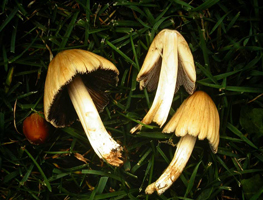
Grows scattered to clustered on humus and rotting wood
Cap – 1.5 to 3 cm tall and 1 to 1.5 cm wide, hemispheric to bell-shaped, medium to deep tan, sulcate-striate, dry, graying in age
Gills – Adnexed to free, tan when young, blackening in age, close to crowded, broad
Flesh – Tan, very thin
Stalk – 4 to 12 cm by 3 to 8 mm, white to pale tan, smooth, hollow
Spore print – Dark brown to black
Spores – 7-11 x 4-6 microns, elliptical, entire
Comments: This rather common species grows from early July to early October. It is also seen at the Logan Creek Preserve, Newport Park, The Rushes Kangaroo Lake trails and Whitefish Dunes. |
Coprinus silvaticus (Coprinaceae) Woodland Ink Cap
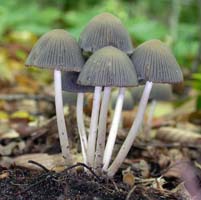
Grows cespitose on soil in mixed hardwoods
Cap – 3 cm wide by 2 cm high, hemispheric, brownish-gray with tan disk, plicate-striate, ragged margins, very young caps are medium brown
Gills – adnexed, black, close to sub-distant, turning inky
Flesh – nearly none
Stalk – 5-6 cm x 5 mm, central, cylindrical, white, tan near base which is tomentose, hollow, very fragile, no ring, slight bulb
Spores – black, oval, spiny or furry, apical pore, 11-13 x 7-9 microns
Comments – It was found only once in late September at Whitefish Dunes State Park. DNA analysis has not yet been done to change the name of this species (as of 3-22-15). |
Cortinarius alboviolaceus (Cortinariaceae) Silvery-violet Cort
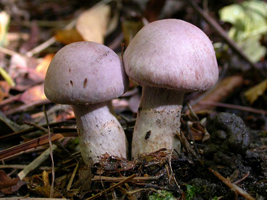 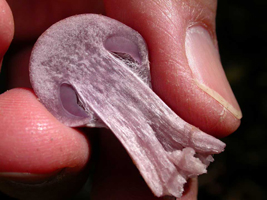 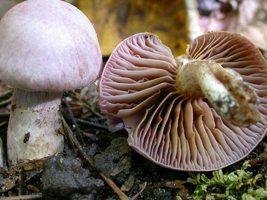 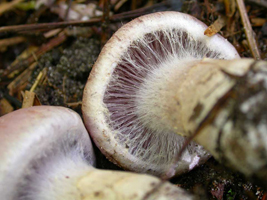
Grows scattered on soil in mixed hemlock and beech woods
Cap – 2 to 6 cm, hemispheric to broadly convex, dull light violet, incurved margin, smooth, dry
Gills – Adnexed to Adnate, medium violet when young, close to sub-distant, medium broad
Flesh – Very pale violet, thick
Stalk – 5 cm by 1.3 cm, pale tan-violet, matted vertical hairs, solid to pithy, slightly enlarged base
Spore print – Medium brown
Spores – 6-9 x 4.5-6 microns, pip-shaped, tuberculate, slightly roughened
Comments: This is rare at Toft Point, reported only once in October 1983 by Veronica Pavlat. It can be found from September to early October and has also been seen at The Mink River Preserve. |
Cortinarius armillatus (Cortinariaceae) Bracelet Cortinarius
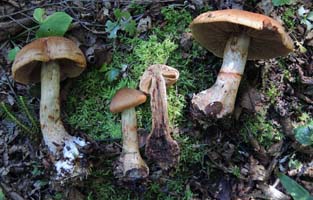 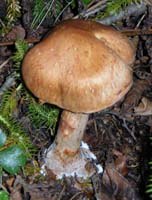 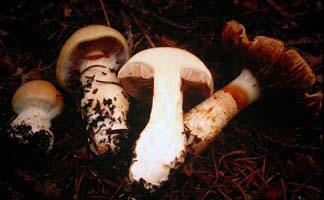 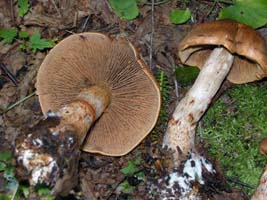
Grows single to scattered on soil or very rotten wood under mixed hardwoods and conifers; it is mycorrhizal with Birch trees
Cap – 2-11 cm, hemispheric to broadly convex with a low broad umbo, light to rich orange-brown, smooth disk, dry, matted fibers, margin fringed with cortina veil fibers
Gills – adnexed to slightly sinuate, light yellow-tan when young, close to sub-distant, medium-broad
Flesh – medium-thick, tan to medium-brown, nice odor
Stalk – 6-11 cm x 1-4 cm, central, bulbous, tapers upward, light brown, tough, cartilaginous, fibrous-striate, median flat orange band of tissue, solid
Spores – rusty brown, elliptical, roughened, 8-12 x 5-7 microns
Comments – grows from August to October and has been found in Newport State Park, Whitefish Dunes State Park and the Mink River Preserve |
Cortinarius cinnamomeus (Cortinariaceae) Common Cort
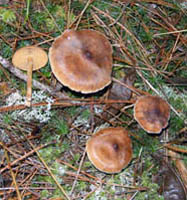  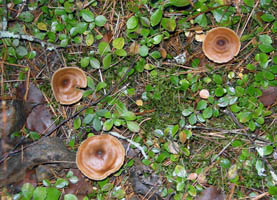
Grows scattered on soil or in moss under conifers
Cap – 4-5 cm, very broadly convex to plane with a darker pointed umbo, orange-brown, satin smooth, striate margin, hygrophanous
Gills – Adnate to sinuate, very broad, close to sub-distant, entire-edged
Flesh – Medium-thin, medium brown, mild nice odor
Stalk – Central, cylindrical to slightly flexed, 8-9 cm x 5-9 mm, tan, fibrous-striate, satin sheen, pithy becoming hollow
Spore print – Rusty Brown
Spores – Elliptical, roughened to slightly tuberculate, 7-10(12) x 4.5-5(6) microns
Comments: Found from late August to early November; last seen in 1979! |
Cortinarius corrugatus (Cortinariaceae) Wrinkled Cortinarius
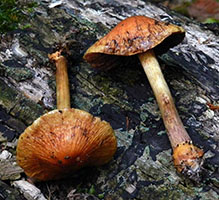  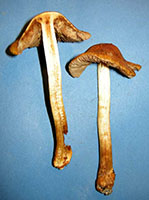
Grows single to scattered on soil under pines and other conifers or in maple beech climax forest
Cap – 7 cm, plane, peanut butter brown, glutinous, scattered short radial streaks of red-brown near margin
Stem – 6 cm by 1.4 cm, central, bulbous (bulb is 2.5cm wide) apex is light tan, rest is medium light brown, fibrous-striate, evanescent ring, slimy when fresh becoming tacky
Gills – sinuate, gray-tan becoming rusty with spores, very broad, close to crowded
Spores – dark brown, football to lemon shaped, very tuberculate, 11-15 x 7-8 microns
Comments – This was found for the first time in October at the Logan Creek Preserve
|
Cortinarius mucosus (Cortinariaceae) Slimy Cortinarius
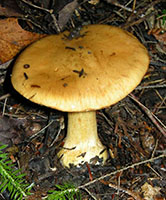 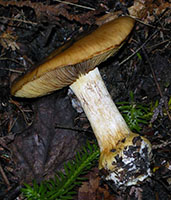 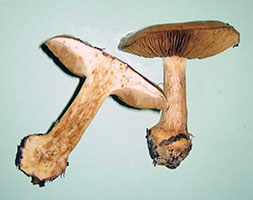
Grows single to scattered on soil under pines and other conifers or in maple beech climax forest
Cap – 3-4 cm, broadly convex, deep yellow-brown, very viscid, margin incurved
Gills – adnate, light gray-tan, close, medium-broad
Flesh – light tan, thick, faint slightly unpleasant odor
Stalk – 4-6 cm x 1 cm, central, cylindrical, tapers downward, apex is light tan, base is medium tan, fibrous-striate, solid, tough
Spores – medium brown, almond shaped to elliptical, roughened to slightly tuberculate, 13-16.5 x 6-8 microns
Comments – found only once in early October 2003 in the Door County Land Trust Kangaroo Lake Preserve; is a part of the large Cortinarius collinitus group of similar species. |
Cortinarius muscigenus (Cortinariaceae) no common name
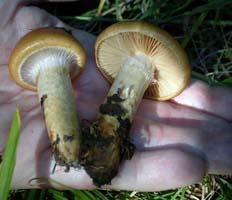
Grows scattered on soil under mixed conifers and hardwoods
Cap – 3-4 cm, broadly convex, deep yellow-brown, very viscid, margin incurved
Gills – adnate, light gray-tan, close, medium-broad
Flesh – light tan, thick, faint slightly unpleasant odor
Stalk – 4-6 cm x 1 cm, central, cylindrical, tapers downward, apex is light tan, base is medium tan, fibrous-striate, solid, tough
Spores – medium brown, almond shaped to elliptical, roughened to slightly tuberculate, 13-16.5 x 6-8 microns
Comments – found only once in early October 2003 in the Door County Land Trust Kangaroo Lake Preserve; is a part of the large Cortinarius collinitus group of similar species. |
Cortinarius pseudosalor (Cortinariaceae) no common name
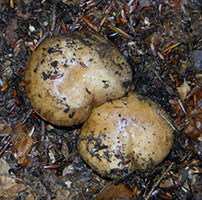 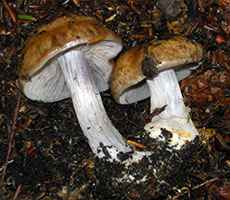 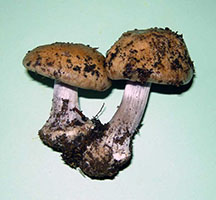 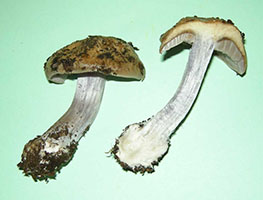
Grows scattered to cespitose on soil in mixed woods
Cap – 4cm, broadly convex, medium-tan, viscid to tacky, not striate
Stem – 3-6 cm by 1-1.3cm, central, terete, pale purple inside and on exterior, cartilaginous, pithy
Gills – adnexed to adnate, dull purple to rusty brown with spores, close, medium-broad
Flesh – tan, medium-thick, no odor
Spores –milk chocolate brown, elliptical, tuberculate, 9-15 x 6-8.5 microns
Comments – First and only time seen was in October at Logan Creek Preserve.
|
Craterellus cornucopoides (Cantharellaceae) Horn of Plenty

Grows solitary to scattered or in loose groups on soil in mixed woods
Cap – 1 to 7 cm wide and 3 to 10 cm tall, deep funnel, gray to black fading to gray-brown, smooth to minutely scaly
Gills – None, fertile surface on underside of funnel is smooth to lightly veined or wrinkled, lighter gray than top of cap
Flesh – Gray to black and very thin, pleasant odor
Stalk – Part of base of funnel, very narrow and black
Spore print – White to buff
Spores – 8-11 x 5-7 microns, elliptical, entire, non-amyloid
Comments: This is quite rare and difficult to find, blending in with the dark forest floor. It has thus had few records, the most recent being October 1983 by Veronica Pavlat. |
Craterellus fallax (Cantharellaceae) Black Trumpet
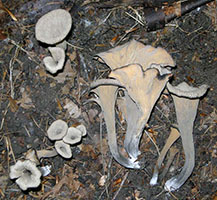  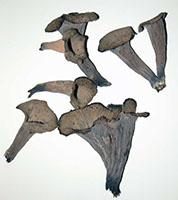
Grows scattered to gregarious on soil in mixed woods
FB – 4-7 cm tall, top is 2.5-6 cm wide, gray-brown with many raised dark brown clumps of fibers giving it a dotted look; deep funnel
Underside – tan in youth, gray to dark gray in age, finely wrinkled
Base – whitish, some are cespitose
Spores – pale orange, non-amyloid, elliptic, smooth, 11-15 x 7-9 microns
Comments – These have been found mostly in September and have been seen in the Mink River preserve, on Washington Island and on private land.
|
Craterellus ignicolor (Cantharellaceae) Golden Funnel Caps
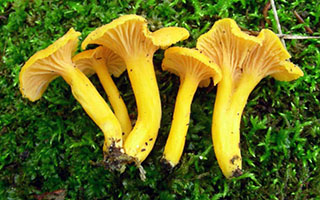 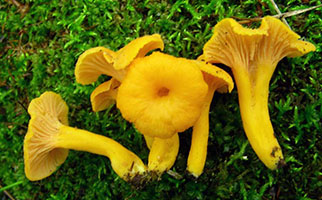
Grows clustered in moss along wooded trails in mixed woods
C – 2-3 cm, very broadly convex to funnel shape with hole in center, deep yellow, smooth to finely fibrillose, hygrophanous
Stem – 2-3 cm by 3-8 mm, central, cylindrical, tapers downward, concolor, smooth, pithy to hollow
Gills – decurrent, distant, concolor, blunt and shallow, a few cross-veined
Flesh – thin, concolor
Spores – white, non-amyloid, elliptical, smooth, 10-13 x 6-8 microns
Comments – First time found in mid-September on Rock Island |
Crepidotus applanatus (Crepidotaceae) Little White Crep
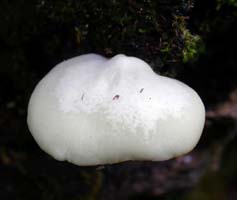 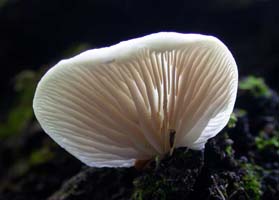
Grows single, scattered or clustered on dead hardwood logs and stumps
Cap – 2-3 cm wide by 2 cm deep, dimidiate, convex, dull chalky white, smooth, hygrophanous, slightly incurved margin, no stalk
Gills – light tan, broad, close
Flesh – white, thin, no odor
Spores – brown, nearly round, roughened, 4.5-6 (7.5) microns
Comments – This looks like a white seashell. It grows in August and September and has been found at Whitefish Dunes State Park and on Washington Island. |
Crepidotus crocophyllus (Crepidotaceae) no common name
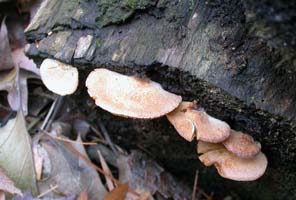 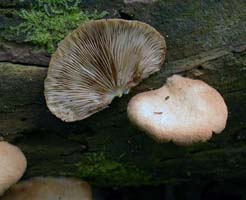
Grows scattered to gregarious on rotted hardwood
Cap – 2-6 cm wide by 1-2.5 cm deep, dimidiate, finely furry surface, brown hairs over cream-tan color cuticle, hygrophanous, slightly striate margin, lateral attachment is furry
Gills – yellowish, broad close
Flesh – white, medium-thick to thin
Spores – medium grayish-brown, round, entire but slightly roughened, 4.5-7.5 microns
Comments – grows from early August to mid-October and has been found at Newport State Park, Whitefish Dunes State Park and Meridian County Park; formerly called Crepidotus dorsalis. |
Crepidotus mollis (Crepidotaceae) Jelly Crep
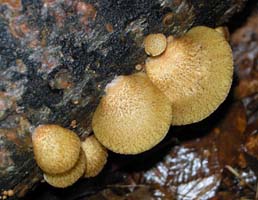 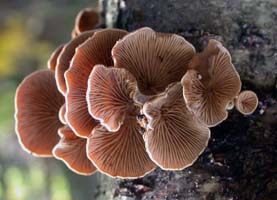 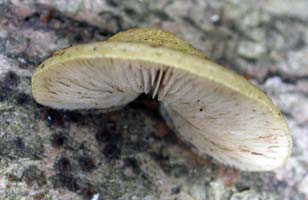
Grows scattered to gregarious in overlapping clusters on dead hardwoods and sometimes on conifers
Cap – 2-6.5 cm, fan-shaped, light tan cuticle with dark brown hairs over all, hygrophanous, slightly striate, tacky; no stalk
Gills – close, pale tan to brown, broad, all radiate in a semi-circle
Flesh – thin, pale tan, concolor with gills
Spores – medium brown or milk chocolate brown, elliptical, smooth, 6.5-10 x 4-7 microns
Comments – This is one of the more common species that grows from June to October and has been found at the Mink River Preserve, Ridges Sanctuary, Newport State Park, Whitefish Dunes State Park, the Clearing School woods, Rock Island and Logan Creek Preserve. |
Crinipellis campanella (Tricholomataceae) no common name
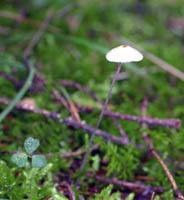 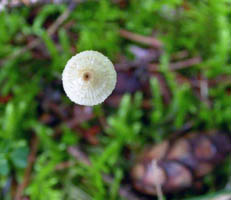 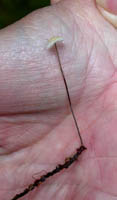
Grows scattered on soil or woody debris under conifers
Cap – 8 mm, broadly convex, brown fading to tan with dark brown umbilicate center, fine dark hairs over all (seen with a 10 X lens), hairy margin, cap is dextrinoid with Melzer’s Reagent
Gills – Adnexed to nearly free, pale tan, close (difficult to see due to tiny size)
Flesh – too tiny to see
Stalk – Central, cylindrical, 5 cm x .5mm (1/2 mm), dark gray, fine whitish hairs over all
Spore print – White
Spores – Elliptical, non-amyloid, smooth, 6.75-8 x 3-4 microns
Comments: found growing on an Arborvitae (Cedar) twig in September near east end of big field; area is now under large fallen Eastern Hemlock |
Cyptotrama asprata (Tricholomataceae) Golden Scruffy Collybia
 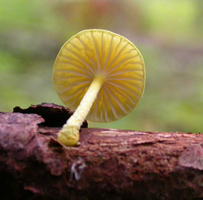 
Grows single to widely scattered on dead hardwood
Cap – 1.5 to 2.5cm, very broadly convex, egg-yolk yellow, dry, scurfy granular, raised wrinkled surface
Gills – adnate to short-decurrent, sub-distant, pale yellow to white, very broad
Flesh – thin, white to pale yellow
Stalk – central to slightly off-center, cylindrical, scurfy-scaly, concolor with cap, tough, solid to pithy
Spore print – white |
Cystoderma amianthinum (Tricholomataceae) Pungent Cystoderma
 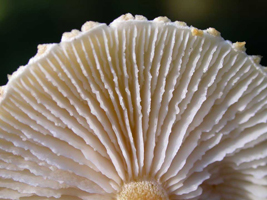
Grows scattered on soil under conifers
Cap – 2 to 3.5 cm, broadly convex to flat, disk light orange-brown with low umbo, margin is yellow-tan, faintly radially wrinkled, granular texture, margin sometimes adorned with veil remnants, not hygrophanous or viscid
Gills – Adnate or adnexed to sinuate, white, broad, close to crowded, edged eroded and unevenly wavy
Flesh – Dull medium yellow-tan, thick at center only
Stalk – 3 to 7 cm by 3 to 6 mm, tapers downward to a small bulb, central, cylindrical, medium yellow-brown, apex light tan pruinose above evanescent ring, scurfy-scaly below ring, pithy to hollow
Spore print – White
Spores – 5-7.5 x 3-4.5 microns, elliptical, entire, amyloid
Comments: This mushroom is beautiful and fun to examine with a ten-power hand lens. It is never abundant being seen only a few times at Toft Point from mid September to mid October. It has also been seen at Whitefish Dunes. |
Cystoderma amianthinum var. amianthinum (Tricholomataceae) no common name
 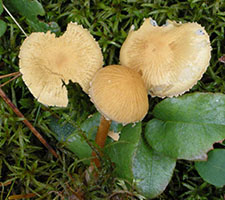
Grows scattered on soil or in moss in conifer woods
Cap – 2-4 cm, broadly convex, radially wrinkled and slightly granular surface, orange-yellow to light orange-brown, margin fringed with bits of partial veil
Stem – 3–7 cm by 3–8 mm, central, cylindrical, apex pale tan & faintly striate, median to superior granular evanescent ring, base medium brown, pithy
Gills – adnexed to sinuate, close to crowded, white, medium broad
Flesh – pale tan to medium yellow, medium thick, no odor
Spores – white, amyloid, elliptical, smooth, 4-7 x 3-4 microns
Comments – These have been seen in September and October and have been found at Toft Point and the Ridges Sanctuary. |
Cystoderma amianthinum var. rugosoreticulatum (Tricholomataceae) no common name
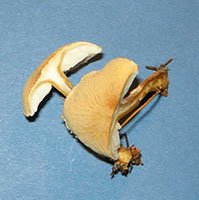 
Grows single to scattered on soil or in moss in mixed conifer woods
Cap – 2-3.5 cm, broadly convex, rich tan to medium yellow brown with darker small umbo, radially wrinkled and granular texture, margin sometimes with fringed bits of partial veil
Stem – 3-5 cm by 4-5 mm, central, cylindrical, tapers downward, apex light brown, thin median-superior evanescent ring, scurfy scaly below ring, medium brown, pithy
Gills – adnexed to slightly sinuate, white, close, broad, edges widely scalloped
Flesh – tan to yellow-tan, thick only at umbo
Spores – white, amyloid, elliptical, smooth, 4-5.5 x 2.5-3.5 microns
Comments – These have been seen in September at Whitefish Dunes State Park and Toft Point. |
Cystoderma granosum (Tricholomataceae) no common name
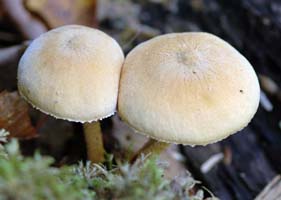 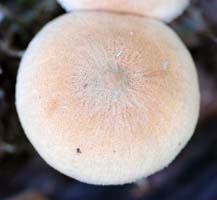 
Grows single to scattered on well-rotted hardwoods
Cap – 3-5 cm, broadly convex to nearly hemispheric with a small umbo surrounded by wrinkles; umbo is rich light yellow-brown, rest of cap lighter tan, all covered with minute granules (looks like salt with a 10 X magnifier lens), dry, unpolished
Gills – adnate to slightly sinuate, cream to pale yellow, very broad, close
Flesh – very thin, medium yellow-brown
Stalk – 5-6 cm x 7-8 mm, tapers upward, apex honey brown and smooth above median ring, base is bulbous with woody debris clinging to it, granular coated below ring, pithy with a hard rind
Spores – white, amyloid, fat oval, smooth, 4-5.5 x 3-4 microns
Comments – found only once at Whitefish Dunes State Park in October 2006; three at the base of a well-rotted Sugar Maple stump. |
Cystoderma granulosum (Tricholomataceae) no common name
 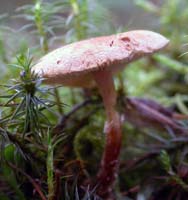
Grows scattered on soil under conifers
Cap – 2-4 cm, very broadly convex, medium orange-brown, floccose, dry
Gills – adnexed to short decurrent, white to pale tan, close, broad, even edges
Flesh – thin, pale tan
Stalk – 3-5 cm x 2-10 mm, central, cylindrical, light to medium brown, median to superior insubstantial ring of small fibers, floccose and shaggy below the ring, pithy, tough, cartilaginous
Spores – white, non-amyloid, elliptical, smooth, 3-5 x 2-3 microns
Comments – It grows in September and October and has been found at Whitefish Dunes State Park, Toft Point and Washington Island. This might be Cystoderma cinnabarinus; needs more study. |

